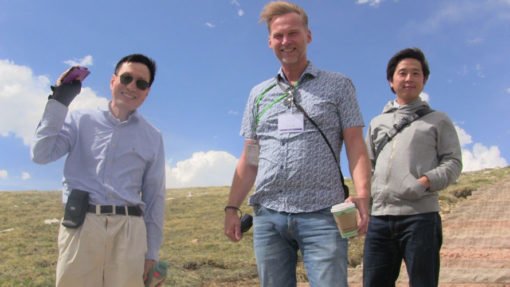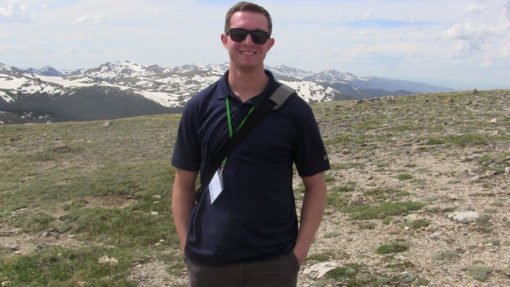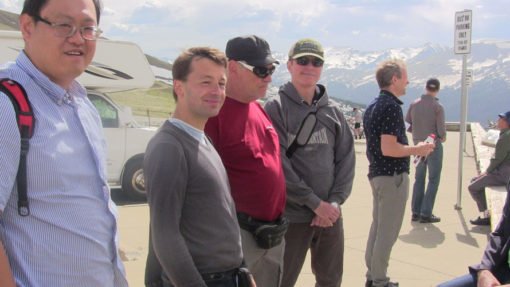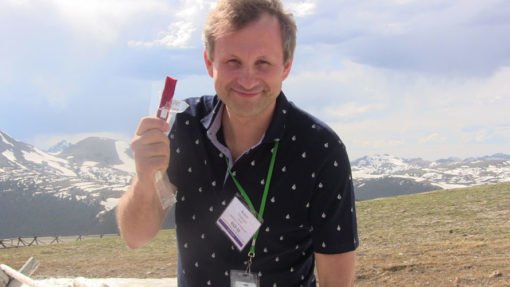- 21st International Conference on Condensed Matter Nuclear Science
ICCF-21 Presentation Index
Monday, June 4
Tuesday, June 5
Wednesday, June 6
Thursday, June 7
Thursday evening Awards Banquet
Friday, June 8 Presentations and Summary
 Materials session Chair Jirota Kasagi of the Research Center for Electron-Photon Science at Tohoku University began a third day of lectures by introducing Edmund Storms who was scheduled to present The Loading and Deloading Behavior of Palladium Hydride but changed to The enthalpy of formation of Pd-H as a function of H/Pd atom ratio and treatment with other useful information.
Materials session Chair Jirota Kasagi of the Research Center for Electron-Photon Science at Tohoku University began a third day of lectures by introducing Edmund Storms who was scheduled to present The Loading and Deloading Behavior of Palladium Hydride but changed to The enthalpy of formation of Pd-H as a function of H/Pd atom ratio and treatment with other useful information.
Presentation .pdf http://lenr-canr.org/acrobat/StormsEtheenthalp.pdf
A new method using the recombiner temperature reveals information about the D/pd ratio of the pd cathode, the enthalpy of formation of Pd-D, and the errors caused by periodic recombiner failure. Many recombiners are faulty and give erroneous data as it is.
Storms’ system set-up uses Electrolyte of 0.5 ml H2SO4 + 30 ml H20, a Seebeck-type calorimeter, three different sources of Pd, and Commercial sheet. The cell is a Pyrex cell wrapped with resistance wire which allows the temperature to be changed without changing electrolytic power.
A platinum anode and a cathode attached with a plastic clamp allows it to be removed quickly.
The recombiner is a cloth of carbon with finely divided platinum in it. Any gas in the cell passes by the recombiner on the way to the oil balance. Any gas generated in the cell is communicated to an oil balance which allows the measurement of the orphan oxygen.
Storms built the calorimeter himself. It features 54 thermocouples and other accoutrements that make it a Cadillac of heat-measuring devices, as evidenced by the three other different labs duplicating the very same calorimeter. And, he will help you build one like it, too!
The calorimeter reaches equilibrium in 90 minutes and both the calorimeter and the recombiner are calibrated. Important measurements are the excess power and the recombiner temperature.
It is clear all the Hydrogen available is going in to react with palladium. But at some point, the recombiner is at higher temperature, and the H is not reacting with palladium. This says that all the H is being recombined.
Using the temperature of the recombiner, you can find the relationship between the fraction of H reaction and and the H/Pd ratio. Thus, we know how much hydrogen is reacting, and we know how much energy is produced. This will make significantly tighter conclusions.

H. Nee with Lattice Confinement of Hydrogen in FCC Metals for Fusion Reaction presented by Subadev
Nee uses H isotope density to estimate LENR reaction rates. Barrier height for H atoms in mH-V, mH-V2, mH-VI clusters is ~1 eV confirmed by the TPD. Nee has the Hydrogen confined by the lattice in vacancy-hydrogen clusters to extremely high density, which is not possible in BCC or HPC lattices because of lower embrittlement.
Nee says, “Plasmon ignition could make LENR self-sustained.” His conclusion is that high plasma screening at surfaces make thermonuclear burning at low energy possible, where “energy dissipation is provided by plasmon emission.”
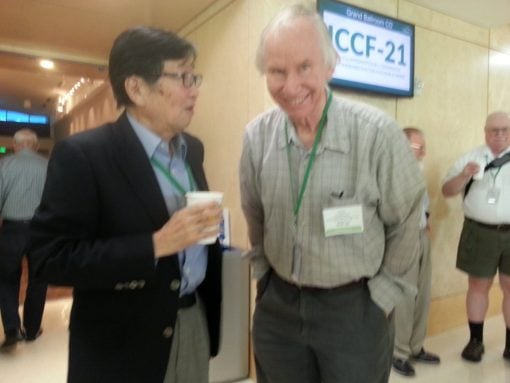
Photo: Jirota Kasagi and Peter Hagelstein at ICCF-21.
P. L. Hagelstein of Massachusetts Institute of Technology with Statistical Mechanics Models for the PdHx and PdDx Phase Diagram with both O-site and T-site Occupation
Hagelstein has developed statistical mechanics models for bulk PdHx separately for the alpha phase (H goes into octohedral sites randomly) and for the beta phase, and also to model the isotherms of the phase diagram. Recently, this has been extended to develop a similar model for the phase diagram of PdDx.
But there are concerns about the data sets available for PdDx. For PdHx, it was possible to make use of previous work that was put into the development of a phase diagram based on individual isotherm measurements, but there do not appear in the literature analogous phase diagrams constructed for PdDx.
A second issue encountered concerns extrapolation into regions of higher loading. For PdHx it was possible to make use of experimental data at relatively high loading and high temperature to develop plausible extrapolations. However, there are fewer available data sets for PdDx, and these do not permit an analogous extrapolation.
What Hagelstein found is the tetrahedral site energy is a fitting parameter in statistical mechanics model.
He showed isotherm graphs that he wishes were more reliable, appealing to Storms to try to determine that.
His conclusions were many, among them T-site occupation at low-loading is predictable.
M. A. Imam of George Washington University with Fabrication, Characterization, and Evaluation of Palladium-Boron Alloys Used in LENR Experiments
Nuclear energies are on the order of 10^6 eV while chemical energies are on the order of about ~1 eV, and in a reaction, there are reactants, proper conditions, and reaction products. Imam wants to talk about the proper conditions aspect, which requires an inter-disciplinary approach, of which Imam focuses on materials science.
Most experiments use Pd or Ni. There are issues about impurities, alloying element grain size dislocations vacancies texture, powder shape, size, and morphology as well as other issues.
Since 1989, research has focused on Pd. At the Naval Research Lab NRL, Imam made many different alloys based on the impurities and elements in palladium, but Pd-B, Pd-Ce, and Pd-Ag are the three he discusses today.
He would begin by taking Pd 99.99% pure and used arc melting, and then applies the additional material. There are grains size changes between Pd pure and Pd-Ag and the micro-hardness changes for Pd-Ag, decreasing at higher temperature. Small grain size makes harder material, large grain size is less so.
For Pd-B, adding boron gives two phases with different lattice parameter, one phase being distributed as fine particles within the other phase. This also minimizes the activity of dissolved oxygen in the palladium by converting it to B2O3 during processing. Average grain size of Pd-B is about 90 micrometers.
NRL palladium and Pd-Ag gave no excess heat, while Pd-B gave excess heat at NRL. Pd-B samples produced excess power in 7 out of 8 China lake studies (one sample had a long crack). Imam hopes to get funding to make some more of this material.
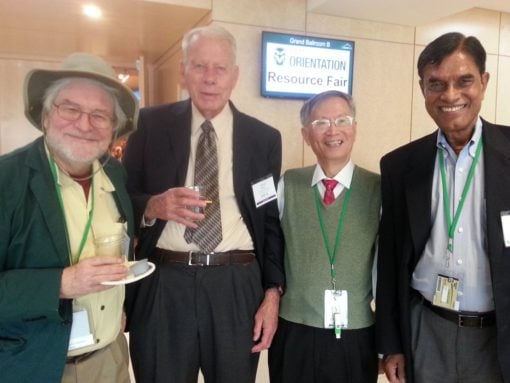
Photo: Abd ul-Rahman Lomax, Melvin Miles, Xing Zhong Li, M.A. Imam at ICCF-21.
M. H. Miles followed up with Excess Power Measurements For Palladium-Boron Cathodes
Presentation .pdf http://lenr-canr.org/acrobat/MilesMexcesspowe.pdf
He began with a historical about the NRL program of research which ran from 1992-1995. One of the major goals of the NRL program was to make their own materials.
His cell was a small glass test tube using 18.0 mL Electrolyte. There is a heat integrator and outer water jacket with the whole apparatus insulated. Cells A, B, C, and D were identical; nothing was changed.
Nothing from the NRL samples produced excess heat until May 1994, when the Pd-B gave excess heat of P (max) was 330 mW where there was 0.75% weight of boron.
A second experiment for cell B using the same Pd-B cathode fared better at 420 mW.
Cell C produced no excess heat and the Pd-B folded over the metal region like a giant crack.
Cell D gave the best result with excess power of 380 mW. It kept getting better as time went on, but they had to stop the cell.
A table showing 0.75% weight B, 0.50% weight B, 0.25% weight B, but there didn’t seem to be any pattern that he could detect. 60 degrees Celsius was the threshold that Fleischmann told Miles; nothing will happen until you get to that temperature.
Miles went to Japan to work in 1997, and used the Fleischmann-Pons type-calorimetry (different than he used before). Miles and Fleischmann did analysis on the same data set, and got similar results, with Miles saying Fleischmann’s analysis was more accurate.
Day 3 excess power was 21.2 mW
Day 6 excess was 17 mW.
In January 1995, he went to NRL to help them get excess power. Pd-B gives about the same enthalpy effect as Pd, but the apparatus was put together so lines would be clogged by gas at some point.
Cell temp should go up in a linear fashion and in an experiment using Pd-B last summer, he showed it did. analysis showed excess power beginning right away as well.
After a short break, Jean-Paul Biberian began the Old and New Experiments session with George Egely on Electric Energy Generation by LENR
Egely began by looking at the earlier literature on electricity and transmutation generation which he says are forgotten effects and inventions.
Isaac Newton and Robert Boyle were pioneers of transmutation through alchemical research. He includes Mary the Jewess IIIrd century Alexandrea, Nicolaus Melchior 1531, and Nikola Tesla in 1890’s.
He explained the slanted semi-conductor/sharp edge cathode, and said that this background is necessary in order to do this work generating electricity.
Florian Metzler et al. of Massachusetts Institute of Technology’s Energy Production and Conversion Group then talked about Observation of Non-Exponential Decay of X-ray and Gamma lines from Co-57 on Steel Plates
He is a graduate student of Peter Hagelstein focusing on phonon-nuclear coupling. His interest in the field was sparked by Xing Zhong Li exactly 10 years ago. He noted that newer research in phonons by mainstream researchers may offer some opening for a connection, too.
Matching levels of excitation will connect phonons in the lattices.
Fe-57 are added in a specific location to the surface of a steel plate. Mechanical stress induced by clamps results in dislocation movement in the steel plate, which primarily scatters but also generates high frequency phonons in the THz region, which theory suggests are much more effective in mediating excitation transfer.
Non-exponential decay effects are seen in some of the early experiments. Last August, they found that it was possible to induce the non-exponential decay effect using a thermal stimulation.

Photo: W. H. McCarthy at ICCF-21.
W. H. McCarthy with Light Hydrogen LENR in Copper Alloys.
What can one do with limited resources to benefit the planet? LENR, of course. Common characteristics are that there is little to no dangerous radiation and products, there are many different processes, and McCarthy believes, requires some dynamic system. The working principle is that the reaction is different than hot fusion which does make toxic particles and radiation.
McCarthy has used light hydrogen with Li and B in Cr. The processing and fabrication is easier, you don’t need expensive deuterium, and you can get reasonable energy out. He says you must also have moving charges in the system. McCarthy made a “leaky capacitor”.
There are three phases of this experiment, each involving significantly different processes, complexity and instrumentation:
(1) Hydrogen was loaded into copper-lithium-boron alloys at elevated temperature (400\[Dash]900\[Degree]C) and pressure (about 10 atmospheres). The encapsulated specimens were quenched, and immediately inserted into a calorimeter to detect nuclear heat. That method showed little success. It is apparently too simple.
(2) You can use Low Q capacitors whereby cells containing hydrogenated copper\[Dash]lithium\[Dash]boron alloy electrodes separated by a liquid dielectric containing fine graphite particles have been tested. A vacuum-insulated Seebeck calorimeter was used. When the layers of copper alloy are alternately charged, electric currents are constrained to flow through the graphite particles at specific sites, resulting in microscopic variations of charge in the metal and localized electron flows.
Most LENR experiments involve such charge mobility. An example of this anomalous heat effect from a low Q capacitor was exhibited at ICCF-18. That specimen showed a small (about 25 milliwatts, 9% of input), statistically significant (on a three sigma basis) excess heat.
Results from a control specimen, devoid of hydrogen, are indistinguishable from the calibration data of the calorimeter. Other examples using the Low-Q capacitor method will be presented. Infrared images of electrodes producing anomalous heat by this method are being taken.
(3) Substantial reduction of input power to produce a self-sustaining demonstration.
McCarthy showed a graph which indicated 30mW excess power at maximum power of 360 mW iput is 8.3% excess -and presumably – nuclear power.
The last speaker of this session was Brian Roarty who presented A Method to Initiate an LENR Reaction in an Aqueous Solution
He presented this protocol at Iccf-16 in Chennai.
He began with Fleischmann-Pons cell in an open beaker, but the D2O boiling away forced a new design to a sealed steel rector. (All experiments performed at or near the boiling point.) A picture of the reactor was shown and Roarty said a superior host for Li+ is the TMA POSS.
He found a way to initiate the LENR reaction at will. However he had a problem with loss of solution in the recto- which meant leaks, but then, he began to suspect that the small leaks were initiating the reaction!
The reaction initiates with an impulse pressure drop that drives a phase change, with repeatability. Unless you are near the boiling point, this won’t work.
McKubre’s Principle of Disequilibrium states that success occurs in dynamic non-equilibrium systems, not in static systems.
And that was all the morning lectures held. Busses were waiting to take participants to the Wednesday afternoon outing.
I then grabbed a box lunch and rode to Rocky Mountain Park along with two busloads of condensed matter nuclear scientists.




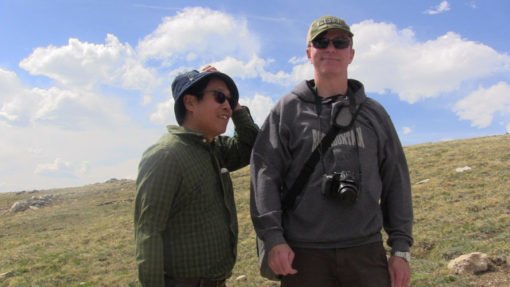
Everybody had a good time – and it lasted all day long!
This image is Martin Fleischmann Memorial Project MFMP Bob Greenyer’s photo from the Summit:

Also Joris V noted that the small yellow flower we saw on the trip is called Hymenoxys grandiflora a.k.a. Rydbergia grandiflora or Tetraneuris grandiflora. (Old Man of the Mountain)
The genus name Rydbergia, accepted by Weber, honors a giant in Colorado botany, Per Axel Rydberg, who wrote Flora of the Rocky Mountains and Adjacent Plains in 1917, but the genus name accepted by almost all other botanists is Hymenoxys. —http://www.swcoloradowildflowers.com/Yellow%20Enlarged%20Photo%20Pages/hymenoxys%20grandiflora.htm






